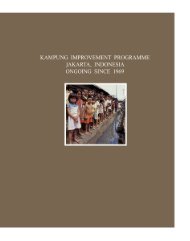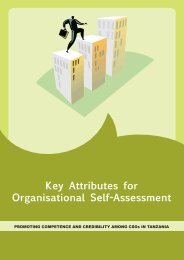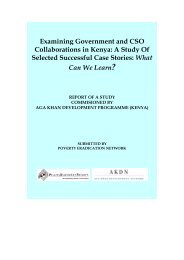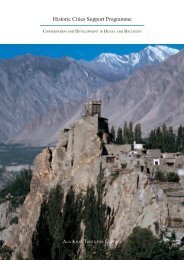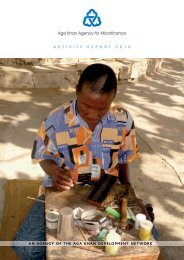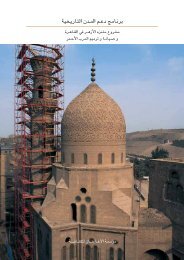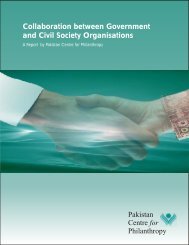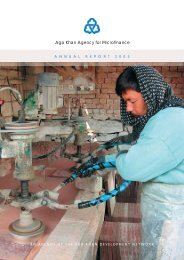Baltistan & Hunza - Conservation and Development Projects
Baltistan & Hunza - Conservation and Development Projects
Baltistan & Hunza - Conservation and Development Projects
- No tags were found...
Create successful ePaper yourself
Turn your PDF publications into a flip-book with our unique Google optimized e-Paper software.
<strong>Conservation</strong> <strong>and</strong> <strong>Development</strong> <strong>Projects</strong>1
2Baltit Fort looks out over the <strong>Hunza</strong>Valley <strong>and</strong> the upper Karimabad village.C O N S E R VA T I O N A N DD E V E L O P M E N T P R O J E C T SREL ATE D PROJ ECTS :In the <strong>Hunza</strong> Valley, the Aga Khan<strong>Development</strong> Network (AKDN) hasimplemented or supported a varietyof community-based projects. Theseinclude the restoration <strong>and</strong> re-use ofBaltit Fort; rehabilitation of the historicvillages of Karimabad, Ganish<strong>and</strong> Altit; construction <strong>and</strong> runningof schools, including a higher secondaryschool for girls; branches of theFirst MicroFinance Bank; health units;safe water <strong>and</strong> sanitation projects forgreater Karimabad, Ganish, Altit <strong>and</strong>other communities; support for theKarimabad Town Management Society<strong>and</strong> other organisations dedicated tosustainable development; mini-hydroelectricplants that supply electricityin remote villages; tourism facilitiesincluding the Baltit Inn <strong>and</strong> Gilgit SerenaInn; income-generating activities<strong>and</strong> savings programmes; <strong>and</strong> kilometresof new or repaired irrigationcanals, bridges <strong>and</strong> other infrastructure.In addition, AKDN institutionshave planted over 10 million trees<strong>and</strong> brought 33,000 new hectares ofagricultural l<strong>and</strong> under cultivation inGilgit.When it began working in the Northern Areas of Pakistan, in 1992, the AgaKhan Trust for Culture’s restoration <strong>and</strong> revitalisation activities became themost visible part of a broad area development programme undertaken by agenciesof the Aga Khan <strong>Development</strong> Network (AKDN). Encompassing cultural,economic <strong>and</strong> social development, the programme included microfinance, agriculturalprogrammes, health, education, the introduction of clean-water supplies<strong>and</strong> sanitation facilities, construction of mini hydro-electric plants, theimprovement of public open spaces, community-driven village rehabilitation<strong>and</strong> house renovation.Baltit Fort, the Trust’s first project (undertaken by the Historic Cities SupportProgramme), was completed in 1996. The <strong>Hunza</strong> Valley settlements of Karimabad<strong>and</strong> Ganish, <strong>and</strong> projects in <strong>Baltistan</strong>, were completed in subsequentyears. While the Trust provided the technical expertise, much of the labour<strong>and</strong> material was provided by the communities themselves. In addition to restorationefforts, the Trust also focused on reviving traditional skills, generatingnew employment opportunities <strong>and</strong> providing training in the jobs needed for achanging economy.To sustain improvements in the quality of life brought about by these projects,Town Management Societies were charged with defining future strategies <strong>and</strong>creating local institutions capable of operating <strong>and</strong> maintaining restored l<strong>and</strong>markbuildings <strong>and</strong> settlements. New local NGOs have also been groomed torevive <strong>and</strong> market traditional local crafts, such as weaving, embroidery, woodcarvingor gemstone production.Local communities have regained interest <strong>and</strong> pride in their local heritage. Traditionalhousing that had been at risk of being ab<strong>and</strong>oned has been restored, upgraded<strong>and</strong> reoccupied. In the process, residents have shown that maintaininglocal building traditions can go h<strong>and</strong> in h<strong>and</strong> with improved living st<strong>and</strong>ards.This lesson has not been lost on other communities. The rehabilitation movementhas now spread to other parts of the Northern Areas, <strong>and</strong> many historicvillages, such as Altit, Shigar <strong>and</strong> Khaplu, have been or are being upgraded withassistance from the Aga Khan Trust for Culture.
3BALTIT FORTK A R I M A B A D , H U N Z A<strong>Conservation</strong> projects in the <strong>Hunza</strong> Valley began with the 700-year-old BaltitFort <strong>and</strong> eventually encompassed the traditional settlements in Karimabad.Baltit Fort was described by a visitor in 1979 as “a labyrinth of dark, smelly,dusty rooms” with decaying roofs pierced by holes <strong>and</strong> cracked walls thatleaned precariously outside foundation lines. Yet it was undoubtedly a masterpieceof craftsmanship <strong>and</strong> thoroughly adapted to climate <strong>and</strong> function.Restoration work began on the Fort in 1992 <strong>and</strong> was completed in 1996. Ithas since become a local history museum <strong>and</strong> cultural centre.The villages <strong>and</strong> neighbourhoods around the Fort, which were in danger ofbeing deserted in favour of new construction, have been rehabilitated with theactive participation of residents. In most cases, the traditional houses havenow been reoccupied. The key to this successful revitalisation effort has beenthe introduction of contemporary living st<strong>and</strong>ards, including piped water <strong>and</strong>sanitation systems. To plan future strategies for the growth <strong>and</strong> developmentof the town, a Town Management Society has been set up with the assistanceof the Trust.In <strong>Hunza</strong>, Old Karimabad traditionalsettlement <strong>and</strong> housing clusters.
4Altit Historic SettlementLibraryWater Treatment PlantA L T I T , H U N Z AJamat KhanaSanitation PlantOld ShopsGovernment DispensaryAltit FortWhite ApricotNew Beacon High SchoolDJ SchoolPolo GroundKisar InnOld HouseTreatment PlantAltit village settlement <strong>and</strong> fortbuilt on a cliff high above the<strong>Hunza</strong> river.The same phenomenon of desertion had occurred in Altit, a village located atthe foot of the 900 year-old Altit Fort. Nearly a third of the homes had beenab<strong>and</strong>oned. New construction was using up valuable arable l<strong>and</strong>.In an attempt to address this phenomenon <strong>and</strong> pre-empt the socio-economicconsequences expected from a tourism boom, conservation efforts at Altitproceeded in reverse order: the village rehabilitation before the Fort. As inKarimabad, the introduction of water <strong>and</strong> sanitation facilities has proven vitalto the revitalisation of the traditional settlement.The conservation strategy for Altit Fort developed in 2004 calls for preservation“as found”, that is, basically as an empty shell. Most conservation worksrelate to mending structural defects, stabilising <strong>and</strong> repairing existing walls,replacing some roofs, treating wood decay <strong>and</strong> providing appropriate lighting.
5Open SpaceG A N I S H , H U N Z AOswa Public SchoolCommunity PondCourtyardImam BargahBudinkutz MosqueGovernment SchoolShaikutz MosqueKuyokutz MosqueRapikutz MosqueKuyokutz MosqueYarikutz MosqueJataqMamorokutz Mosque<strong>Conservation</strong> in Ganish has centred on historically important spaces such asthe jataq, a traditional communal space used for public meetings, ceremonies<strong>and</strong> festivals. The use of this space had long been ab<strong>and</strong>oned <strong>and</strong> the fourexceptional mosques around the jataq were in a near state of collapse.Restored community pond<strong>and</strong> surroundings in the centreof Ganish village.The Trust restored the mosques <strong>and</strong> the public space using methods developedin the conservation of Baltit Fort <strong>and</strong> Karimabad. Restoration also involvedthe remaining towers <strong>and</strong> gates of the original fortifications. The communitypond or “pharee” was also rebuilt <strong>and</strong> the village guesthouse was restored.Today, the Ganish Khun Heritage <strong>and</strong> Social Welfare Society manages the conservation,rehabilitation <strong>and</strong> maintenance of the village, as well as a wide rangeof social projects. Sales of entrance tickets to the complex generates incomefor the collective use of the community.
6Garden HouseS H I G A R , B A L T I S T A NAmacha GardenShigar Fort sits directly on a four-metrehigh boulder at the foot of a cliff overlookingthe Indus valley. Below, theentrance through the fortified tower.Chinpa SettlementKhlingrong MosqueRaja’s New HouseRaja’s MosqueOld HouseShigar FortHalpapa SettlememtRoad to K-2Old BazarFort RoadP.W.D. Rest HouseAstana SettlementRoad to SkarduShigar HospitalKhanqah-e-MuallahPolo GroundThe restoration of the Shigar Fort/Palace <strong>and</strong> its conversion into the “ShigarFort Residence” builds on a process that began with previous efforts in the<strong>Hunza</strong> Valley. However, while it builds on these earlier efforts, it also representsa pioneering approach that stresses a more active adaptive re-use.Featuring guest rooms that highlight the heritage of the region, the project ismeant to bring cultural <strong>and</strong> economic objectives together in a way that sustainsthe operations <strong>and</strong> maintenance of the Fort while providing a catalyst for economicimprovement in the area.The broader development project in Shigar includes restoration of mosques<strong>and</strong> the rehabilitation of the settlements of Chinpa, Halpapa <strong>and</strong> Khlingrong,including upgrading of water <strong>and</strong> sanitation systems. The fifteenth centuryAmburiq Mosque was restored to demonstrate that conservation of badly damagedmonuments was feasible.
7K H A P L U , B A L T I S T A NKhaplu Palace, picturedin photo but not seenon the map, is anotherc<strong>and</strong>idate for restorationin <strong>Baltistan</strong>.MosqueAKCSP ProjectHunduli SettlementMosqueBanpi SettlementSchoolHealth FacilityKhanqah SettlementSchoolTombKhaplu KhanqahTombAstanaMosqueREL ATE D PROJ ECTS :In the Khaplu area, the Trust has also undertaken restoration of the historicastana (shrine <strong>and</strong> tomb) of Syed Mir Muhammad, in Khanqha Settlement,<strong>and</strong> is studying rehabilitation of Khaplu Fort. The astana restoration includedthe removal of the complete upper part of the building, moving the remainingstructure back into place <strong>and</strong> replacing missing timber elements.The Trust also selected the Hunduli village as the location for a demonstrationproject that would exhibit low-cost improvements, including social services,in individual dwellings <strong>and</strong> public spaces. These improvements were to beundertaken with local labour <strong>and</strong> materials (with appropriate technical assistance).The objective was to show that old homes could be re-adapted to newrequirements – thereby preserving the heritage of the region – <strong>and</strong> that publicspaces could be revitalised in a cost-effective manner. The project is alsointended to revive traditional carpentry <strong>and</strong> construction techniques throughh<strong>and</strong>s-on training <strong>and</strong> to develop innovative uses of traditional materials.In <strong>Baltistan</strong>, the Aga Khan <strong>Development</strong>Network (AKDN) has workedon hundreds of community-basedprojects: restoration <strong>and</strong> re-use ofseveral sites, including Shigar Fort, theastana of Syed Mir Muhammad <strong>and</strong> thesettlements of Chinpa, Halpapa <strong>and</strong>Khlingrong; drinking water <strong>and</strong> sanitationsystems; infrastructure projectsincluding improvement of irrigationcanals, bridges, roads, water supplies,<strong>and</strong> community centres; disaster-mitigationmeasures; microfinance <strong>and</strong> income-generatingactivities centred onapricot oil processing, carpentry <strong>and</strong>gemstones; <strong>and</strong> forestation projectsthat have planted over 8 million trees.
8AGA KHAN TRUST FOR CULTUREHistoric Cities Support Programmewww.akdn.org




